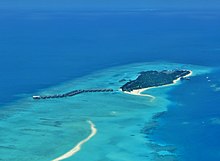Baa Atoll: Difference between revisions
mNo edit summary |
|||
| Line 25: | Line 25: | ||
==Ecology== |
==Ecology== |
||
| ⚫ | |||
[[Image:Malosmadulu Atolls, Maldives.jpg|thumb|left|300px|The Maalhosmadulu Atolls seen from space. The Southern Maalhosmadulu Atoll and Fasdūtherē Atoll (centre) make up Baa Atoll]] |
[[Image:Malosmadulu Atolls, Maldives.jpg|thumb|left|300px|The Maalhosmadulu Atolls seen from space. The Southern Maalhosmadulu Atoll and Fasdūtherē Atoll (centre) make up Baa Atoll]] |
||
[[File:Landaa Giraavaru vue du ciel.JPG|thumb|The [[resort island]] of [[Landaa Giraavaru]].]] |
|||
| ⚫ | |||
Maalhosmadulu Atoll is also considered as a good example of the rich [[biodiversity]] found in the Maldives, including large mangroves and a unique diversity of fauna, such as the benthic fauna. Furthermore, the ring-shaped reef forms known as ''faru'' in the [[Dhivehi language|Dhivehi]] language is a [[reef]] structure which is unique to the [[Maldives]]. |
Maalhosmadulu Atoll is also considered as a good example of the rich [[biodiversity]] found in the Maldives, including large mangroves and a unique diversity of fauna, such as the benthic fauna. Furthermore, the ring-shaped reef forms known as ''faru'' in the [[Dhivehi language|Dhivehi]] language is a [[reef]] structure which is unique to the [[Maldives]]. |
||
Revision as of 16:50, 17 September 2014
Baa Atoll is an administrative division of the Maldives. It consists of three separate natural atolls, namely southern Maalhosmadulu Atoll (which is 42 km long and 32 km wide and consists of 9 inhabited islands), the Fasdūtherē Atoll (wedged in between the two Maalhosmadulu Atolls and separated from north Maalhosmasdulu Atoll by Hani Kandu or Moresby Channel) and the smaller natural atoll known as Goifulhafehendhu Atoll (Horsburgh Atoll in the Admiralty charts).
Situated on the west of the Maldives atoll chain, it consists of 75 islands of which 13 are inhabited with a population of over 11,000 people. The remaining 57 islands are uninhabited, in addition to eight islands being developed as resorts.
Thulhaadhoo Island is traditionally well known for its lacquerwork handicrafts.
NOTE: Haa Alifu, Haa Dhaalu, Shaviyani, Noonu, Raa, Baa, Kaafu, etc. are code letters assigned to the present administrative divisions of the Maldives. They are not the proper names of the natural atolls that make up these divisions. Some atolls are divided into two administrative divisions while other divisions are made up of two or more natural atolls. The order followed by the code letters is from North to South, beginning with the first letters of the Thaana alphabet used in Dhivehi. These code letters are not accurate from the geographical and cultural point of view. However, they have become popular among tourists and foreigners in the Maldives who find them easier to pronounce than the true atoll names in Dhivehi, (save a few exceptions, like Ari Atoll).[1]
Ecology


Maalhosmadulu Atoll is also considered as a good example of the rich biodiversity found in the Maldives, including large mangroves and a unique diversity of fauna, such as the benthic fauna. Furthermore, the ring-shaped reef forms known as faru in the Dhivehi language is a reef structure which is unique to the Maldives.
The southernmost uninhabited island of Olhugiri in the North Maalhosmadulu Atoll lies 13 km north of Goifulhafehendhu Atoll. Olhugiri is well known for its unique natural vegetation and for providing two of the only perching sites for the Great Frigatebird in the Maldives. Likewise, other marine creatures such as seaturtles and hawksbill turtles can be encountered.
The Fisheries Ministry of the Maldives has banned catching turtles or taking eggs from Olhugiri, which also applies to 11 other islands.
Biosphere Reserve
Baa Atoll as a biosphere reserve, Maldives, harbors globally significant biodiversity in its numerous reefs and demonstrates a long history of human interaction with the environment. Covering approximately 139,700 ha of coastal/marine areas, the site is representative of the Maldives’ high diversity of reef animals, with stony and soft corals, reef associated fish species, marine turtles, manta rays and whale sharks. In addition to its 12,170 inhabitants, some 350,000 tourists visit the biosphere reserve annually. As part of a Global Environment Facility (GEF) project, the site has great potential for demonstrating sustainable development throughout the Maldives and the region, while relying on a green economy.
Hanifaru Bay which is known locally as Vandhumaafaru Adi is thought to be one of the few places in the world where whale sharks congregate in to mate although recent research suggests otherwise with the vast majority of the whale sharks seen there being young males. The bay is however regularly sees some of the largest gatherings of Manta rays worldwide with up to one hundred individuals in the small inlet when the tide pushes plankton into the bay.
The designation of Baa Atoll as a UNESCO World Biosphere Reserve in June 2011 was a significant achievement for the Maldives. placing it in the company of world famous sites such as Komodo island in Indonesia, Uluru (Ayer’s Rock) in Australia and the Galapagos Islands.
See also
References
- ^ Tim Godfrey, Atlas of the Maldives, Atoll Editions 2004
- Divehi Tārīkhah Au Alikameh. Divehi Bahāi Tārikhah Khidmaiykurā Qaumī Markazu. Reprint 1958 edn. Malé 1990.
- Divehiraajjege Jōgrafīge Vanavaru. Muhammadu Ibrahim Lutfee. G.Sōsanī.
- Xavier Romero-Frias, The Maldive Islanders, A Study of the Popular Culture of an Ancient Ocean Kingdom. Barcelona 1999.

